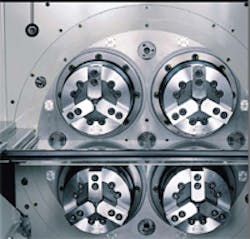When it comes to improving machining operations, most shops focus their time, effort and money on reducing part-cutting cycle times, or how long a spindle is actually in the cut.
What these shops may not realize is that they could be missing some low-hanging fruit of opportunity to further optimize their machining processes without changing them.
Bill Camloh of Camloh Machinery Solutions (www.camlohmachinesales.com), a machine tool representative, said that the low-hanging fruit of opportunity in this case refers to time spent in the cut versus time spent out of the cut – spindle idle time.
If time spent in the cut is 80 percent or less of overall process time, that means spindle idle time is 20 percent or more. And Camloh suggests that is 20 percent or more worth of potential production improvement that may be gained, particularly when applied to jobs of more than 500 pieces and with part-cutting cycle times of 2 min or less.
“Consider reducing a 2-min operation by 20 percent (24 sec), for example. That reduction is not going to impact a job of 100 pieces as much as it would one with 5,000 pieces,” explained Camloh.
One of his customers that was able to reap the benefits of reducing spindle idle time was Ingersoll Rand in Athens, Pa., a manufacturer of pneumatic hand tools.
The company recently replaced an aging, four-lathe machining cell with one (1) automated, four-spindle CNC chucker from Camloh. The chucker is a Kitako MT 4-200, imported by SB Machine Tools (www.sbmachinetools.com). The machine is served by a robotic arm, and the standalone system is part of a large production line.
The Kitako slashed loading time (spindle idle time) from 60 sec per part to about 1 sec per part. While part-cutting cycle times didn’t change, the elimination of idle time allowed Ingersoll Rand to meet its production requirements of 400,000 parts by running two shifts, five days a week. With its previous machining cell, the company ran three shifts, seven days a week to produce the same number of parts. In addition, the standalone chucker freed valuable floorspace, came complete and ready to run with its built-in automation, and relieved the company of maintenance headaches from the old cell.
Two or four spindles?
Bill Camloh often compares the spindle idle-time reduction capabilities of twin-spindle lathes to those of a Kitako 4-spindle chucker. Below is one he did for a shop running 4,000 to 10,000-piece job lots.
For turning a component that goes into an Ingersoll Rand impact wrench, each 18-year-old lathe in the old cell was tied to its own pick-and-place loaders and conveyors that carried parts to subsequent operations. The pickand- place load/unload system, using the machines' turrets and coupled with chuck cleaning and part confirmation, contributed to each machine's 60-sec idle time. Each lathe did the same turning operation, so the cell produced four parts simultaneously.
The company’s new, fully automated MT4-200 standalone machine incorporates an integrated machine-mounted Fanuc robotic arm and turns parts with only two of its spindles. However, it produces the same amount in less time.
Out of the Kitako’s four spindles that are mounted in a carrier drum, one station rough turns parts, and one finish turns them. Both of these operations happen when the chucks are at the lower portion of the carrier drum.
Every 30 sec, the machine carrier drum indexes 90 degrees to move the spindle with a roughed part to the finishing position. The spindle with the finished part moves to an unload position, the spindle with a raw part moves to the roughing position, and the robot loads a new part.
Don Mingos, manufacturing engineer at Ingersoll Rand, said the Kitako provides up-to-date, reliable automation. Its feed system has four pick-up points for the robot to get raw parts from and keeps the machines running for almost an hour at a time between feed-system loadings.
The Kitako takes up one-fourth the space that the old cell did. The old cell, because of its sheer size, involved a lot of legwork. Mingos said that cell operators spent the majority of their time moving parts to incoming conveyors and running, as much as four times every hour, from machine to machine to make sure everything was ok.
Also, maintenance for the old cell became a full-time job, which the Kitako eliminated. In addition, the new machine improved part quality, and Ingersoll Rand no longer had to contend with four separate machines that each produced at different part-quality levels.
| MT4-200 Ki tako’s MT4-200 4-spindle CNC chucker features hardened, precision ground spindles that get support from double-row cylindrical roller bearings and angular-contact bearings. The cartridge-type spindles are lubricated with grease and sealed for reduced maintenance. Their chucks are from Kitagawa Kogyo Co. A carrier drum whose exterior is a large-diameter cervic coupling houses the machine’s spindles and ensures accuracy, rigidity and repeatability when positioning. Two individual 11/15 Kw AC motors drive the spindles for constant speed control. The spindle carrier indexes 90 degrees in 2 sec and 180 degrees in 2.5 sec. The machine’s 8-station drum turret is bi-directional with random indexing. Covers guard machine slides, and forced lubrication for sliding surfaces and ballscrews, coupled with the use of Turcite, ensure longlasting machining precision. Kitako also offers an MT4- 200M model with milling capabilities, as well as two vertical spindle models. |
